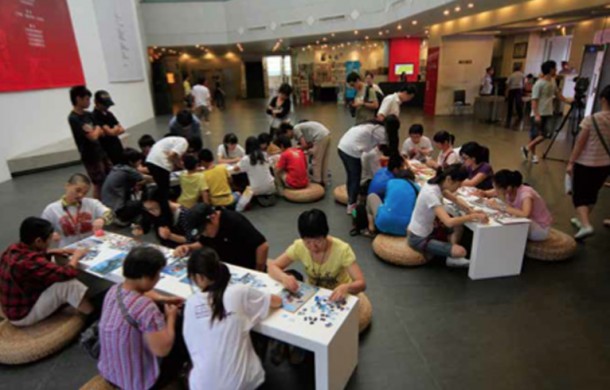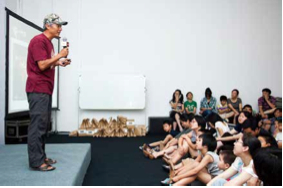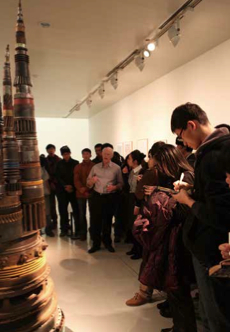THE PUBLIC EDUCATION RESPONSIBILITIES OF PRIVATE ART MUSEUMS
| May 10, 2013 | Post In LEAP 18

Traditionally, public art museums are expected to conduct a certain amount of public education. However, due to China’s emphasis on systematized education, public education programs in public art museums have failed to cast off the traditional educational model of training and lectures. In recent years, private museums have devoted more resources to and employed more creative strategies in their public education programs, due in part to their more diverse sources of funding and their interest in establishing a public image. In this article, Liu Yingjiu, Deputy Director of the Rockbund Art Museum, outlines his suggestions for public education at privately run art museums by clarifying the distinction between the concepts of “private” and “privately run.”
THE ACCUMULATION OF PRIVATE CAPITAL AND THE RISE OF PRIVATE MUSEUMS
The emergence of privately run art museums is the result of China’s socioeconomic transformation and cultural development over the past twenty years. In particular, these museums are closely linked to the development of the real estate industry in this period and the rapid accumulation of individual wealth. During this process, privately run art museums have been established due to a series of interconnected practical and personal factors, such as certain individuals’ fondness for art, certain commercial considerations, and, indeed, certain interest in the public good. However, education has not been an explicitly articulated goal, in sharp contrast to the origins of Western art museums during the European Enlightenment.
Then, under the historical circumstances of transformative modernization, both governments and private individuals established museums with the goal of remaking society. In the West, this historical and societal context means that the association between museums and education is deeply imbedded in the norms of public participation, legal codes, and professional practices. In the 2007 revision of the International Council of Museums’s definition of “museum,” the organization further emphasized that education is the common purpose of museums and various other institutions, demonstrating the consensus on this matter among international specialists (1).
Clearly, due to the discrepancy between historical circumstances and the present context, the administrators of Chinese privately run museums lack an appreciation of the importance of education to the art museum concept. In reality, some private investors seem to first build an art museum out of various practical and personal considerations, and only afterward begin to comprehend the essence and functions of such an institution. This phenomenon could be described as an extension of the special experience of China’s economic transformation— “crossing the river by feeling for the stones”— and perhaps it is a necessary process of China’s modernization. How, then, in the historical circumstances of contemporary China, are we to address the theories and practices associated with the Western concept of the art museum?
THE ORIENTATION OF THE ART MUSEUM IN THE PUBLIC SPHERE
First of all, we must clarify the attributes of the art museum and the conceptual distinction between private museums and privately run museums. Semantically, “privately run” merely indicates something that is nongovernmental in nature, whereas “private” stands in contrast to “public,” and pertains to a different category altogether. According to the definition of the International Council on Museums, “a museum is a non-profit, permanent institution in the service of society and its development, open to the public.” If the operators of privately run art museums accept that being open to the public and serving society are essential characteristics of an art museum— its public nature— then they must recognize that public education is not merely the prerogative of the state, but also a responsibility of theirs as well. The curator Hou Hanru recently suggested at the Rockbund Art Museum 2012 Annual Forum, “Contemporary Art Museum Education in China,” that privately run art museums should be called “privately funded public art museums.” Since the concept of the public sphere has gained status and recognition in Chinese society, such museums should intentionally participate in its construction. In the long term, affirming the public nature of privately run museums will not only differentiate them from private exhibition spaces and other such venues, but also contribute to the closing of the institutional chasm between privately run and state-owned art museums. This process could greatly influence the future development of privately run art museums.
Next comes understanding public education. Public education at art museums includes two aspects: educational ideas and educational programs. Generally speaking, the consideration of educational ideas should permeate the operations of an art museum; educational programs are activities specially designed to communicate ideas and content particular to a museum. Of course, each museum must determine the form, content, and quantity of its educational activities according to its own mission, resources, and specializations, as well as its social and cultural environment. There is no fixed model to follow. We know that the Ullens Center for Contemporary Art (UCCA) can roll out more than 500 high-quality public education programs each year, and this is naturally worthy of our admiration, but we often overlook the fact that an art museum’s exhibitions are in fact its most fundamental and important educational medium, method, and content. A meticulously curated and executed exhibition, accompanied by the requisite information, can effectively achieve an art museum’s educational goals. Of course, this requires the selection and curation of the exhibition to consider its educative nature: the ways in which the art is connected to and significant for the public and community. Privately run museums must treat public education as a challenge requiring the same wisdom and passion as the creation of exhibitions. They must consider more than the form and scale of educational activities, and they must see these activities as more than just extra work thrust upon them by the world outside.
STRENGTHS, LIMITATIONS, AND PROSPECTS
Today, privately run art museums in China have grown numerous and diverse. Aside from their nongovernmental status, it is hard to think of any uniting characteristics or common strengths that these institutions share. Even so, the circumstances of the most influential and successful privately run museums suggest that they enjoy advantages over state-owned museums in terms of organization and vision.
In terms of organization, privately run art museums possess a number of advantages. They employ a more open organizational approach that facilitates energetic teamwork. For example, the education programs at UCCA include a strong international component that is closely linked to the culture of teamwork and the education department’s remarkable capacities for curation and execution. Furthermore, this open organizational approach influences institutions’ community relations. Examples include the “Mobile Art Museum” community outreach program at Shanghai’s Himalayas Art Museum, the Rockbund Art Museum’s “Night@RAM” platform for the production and exchange of local culture, and the series of creative, localized activities put on for local residents by Guangzhou’s Times Museum. These educational programs all feature innovative approaches and local flavor; together, they demonstrate the effectiveness of the flexible and efficient organizational structures of privately run art museums.
On the other hand, it is undeniable that the founders and administrators of some privately run art museums do not yet fully grasp the concept, scope, and significance of museum education. This shortcoming naturally influences the level of attention and resources devoted to educational work at these institutions. Moreover, some privately run art museums do not have the funds, space, or human resources to provide even basic educational programs. These factors are the principle limitations facing educational programs at privately run art museums.
From a long-term perspective, the main challenge facing privately run art museums in the public education field lies in the relationship between each museum’s fundamental mission and how its founders and administrators understand public education: will they foster a sustainable organization by maintaining an active, efficient, and open-minded team with the purpose of developing educational theories and practices suitable to the local environment? At present, in some quarters, this work has already begun and achieved incremental success. Some museums have put forth programs and plans that have generally garnered optimistic reviews. As more private institutions and collectors make plans to establish their own museums or long-term exhibition spaces, particularly in the field of contemporary art, privately run art museums can expect to receive more resources to devote to public education. This trend bears great significance for art education in China. (Translation by Daniel Nieh)
Note
1. See the definition of art museums by the International Council of Museums, as well as “Adjusting and Deciphering the Definition of ‘Museum’ by the International Council of Museums,” Song Xiangguang, Zhongguo Wenwu Bao, March 20, 2009.




